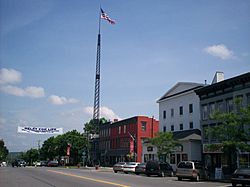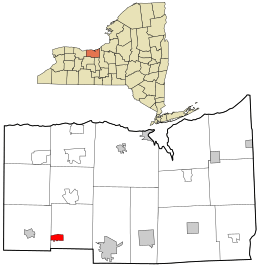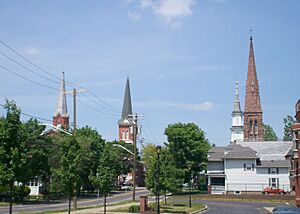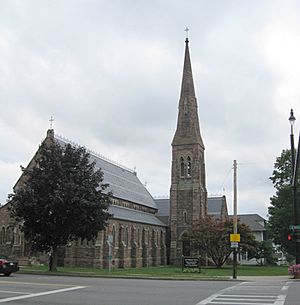Palmyra (village), New York facts for kids
Quick facts for kids
Palmyra, New York
|
|
|---|---|

Downtown Palmyra in 2010
|
|

Location in Wayne County and the state of New York.
|
|
| Country | United States |
| State | New York |
| County | Wayne |
| Town | Palmyra |
| Settled | 1790 |
| Incorporated | March 29, 1827 |
| Named for | Palmyra in the Levant |
| Government | |
| • Type | Board of Trustees |
| Area | |
| • Total | 1.35 sq mi (3.49 km2) |
| • Land | 1.35 sq mi (3.49 km2) |
| • Water | 0.00 sq mi (0.00 km2) |
| Elevation | 480 ft (148 m) |
| Population
(2020)
|
|
| • Total | 3,305 |
| • Density | 2,453.60/sq mi (947.42/km2) |
| Time zone | UTC-5 (EST) |
| • Summer (DST) | UTC-4 (EDT) |
| ZIP Code(s) |
14522
|
| Area code(s) | 315 and 680 |
| FIPS code | 36-56187 |
| GNIS feature ID | 0970448 |
| Website | http://www.palmyrany.com |
Palmyra (pronounced pal-MY-ra) is a small village in Wayne County, New York, United States. In 2010, about 3,536 people lived there. The village and the larger town it's in are both named after an ancient city called Palmyra in what is now Syria.
Palmyra village is located in the Town of Palmyra. It is east of the city of Rochester.
Contents
History of Palmyra
Palmyra was first settled in 1790 by a person named John Swift. It was originally called "Swift's Landing." In 1827, it officially became a village and was named Palmyra. By the year 1900, Palmyra had become an important center for railroads and factories.
Palmyra played a big role in the Underground Railroad. This was a secret network that helped enslaved people escape to freedom in Canada. It is believed that Palmyra helped more than 2,000 people find their way to freedom.
Palmyra is famous for its "four corners." It is said to be the only place in the United States with four churches standing at a main intersection, facing each other. These churches are at the crossing of New York State Route 21 and New York State Route 31.
Many historic buildings in Palmyra are part of the Palmyra Village Historic District. This district was added to the National Register of Historic Places in 2009. This means these buildings are important to the history of the country.
Palmyra is also part of the Erie Canalway National Heritage Corridor. The Erie Canal is a famous waterway that helped connect the Great Lakes to the Atlantic Ocean. Erie Canal Lock 29 is near Palmyra-Macedon Aqueduct Park. A "lock" is like a water elevator that helps boats move up or down different water levels.
Near the lock, you can see parts of the old Palmyra Aqueduct. This was a bridge built in 1857 that carried the Erie Canal over a creek. There's also a special bridge called a "change bridge" (Bridge #35). This type of bridge allowed horses or mules pulling canal boats to switch from one side of the canal to the other. This bridge was first built in 1858.
Palmyra and Early Latter-Day Saint History
In 1830, a very important event happened in Palmyra. The first copies of the Book of Mormon were printed here by a local publisher named E. B. Grandin. Many other important events for the Latter Day Saint movement also took place in Palmyra and the surrounding town.
Today, the Book of Mormon Historic Publication Site is a popular place for visitors. The Church of Jesus Christ of Latter-day Saints has kept this site in good condition since 1978. It was fixed up and reopened in 1998.
Downtown Fire in 2013
On May 3, 2013, a fire damaged several old buildings on Main Street. These buildings were from the time when the Erie Canal was very active. The fire destroyed three buildings, and water used to put out the fire damaged a fourth. The buildings had to be taken down that summer.
Geography of Palmyra
Palmyra village covers an area of about 1.3 square miles (3.4 square kilometers). All of this area is land.
The village is located at coordinates 43°03′47″N 77°13′59″W / 43.063°N 77.233°W. It is part of the larger Rochester area in New York.
Palmyra village is where two main roads, New York State Route 31 and New York State Route 21, meet. The village is also located along the Erie Canal and is south of Lake Ontario.
Palmyra's Population
| Historical population | |||
|---|---|---|---|
| Census | Pop. | %± | |
| 1870 | 2,152 | — | |
| 1880 | 2,308 | 7.2% | |
| 1890 | 2,131 | −7.7% | |
| 1900 | 1,937 | −9.1% | |
| 1910 | 2,268 | 17.1% | |
| 1920 | 2,480 | 9.3% | |
| 1930 | 2,592 | 4.5% | |
| 1940 | 2,709 | 4.5% | |
| 1950 | 3,034 | 12.0% | |
| 1960 | 3,476 | 14.6% | |
| 1970 | 3,776 | 8.6% | |
| 1980 | 3,729 | −1.2% | |
| 1990 | 3,566 | −4.4% | |
| 2000 | 3,490 | −2.1% | |
| 2010 | 3,536 | 1.3% | |
| 2020 | 3,305 | −6.5% | |
| U.S. Decennial Census | |||
In 2010, there were 3,536 people living in Palmyra. There were 1,508 households, which are groups of people living in the same home. About 882 of these households were families.
Most of the people living in Palmyra were White (96.6%). There were also smaller numbers of African American, Native American, Asian, and Pacific Islander residents. About 1.1% of the population was Hispanic or Latino.
The average age of people in Palmyra was about 39.4 years old. About 26.7% of the population was under 20 years old.
Notable Person
- E. B. Grandin – He was the publisher who printed the very first edition of the Book of Mormon in Palmyra.
See also
 In Spanish: Palmyra (villa) para niños
In Spanish: Palmyra (villa) para niños




